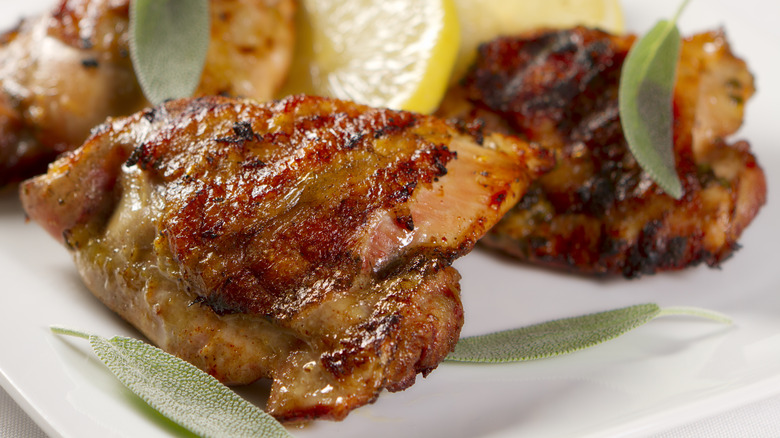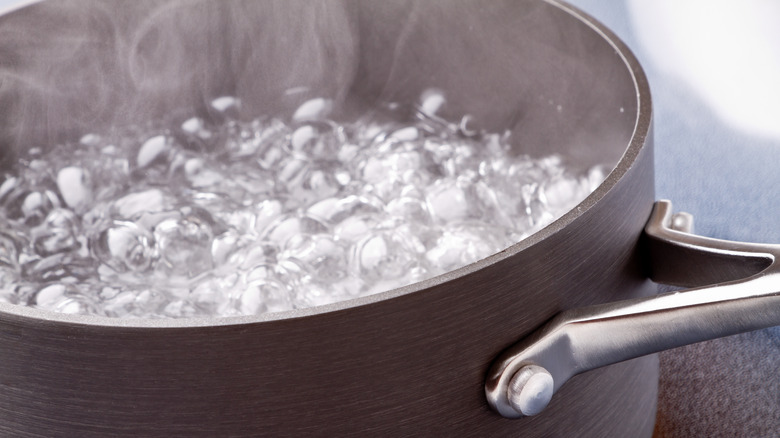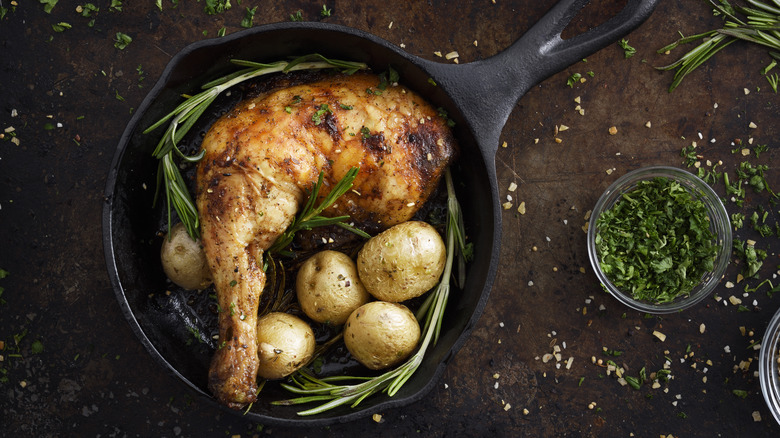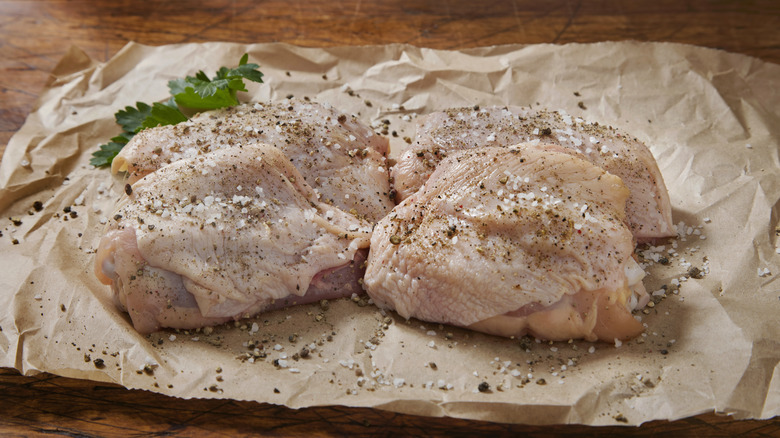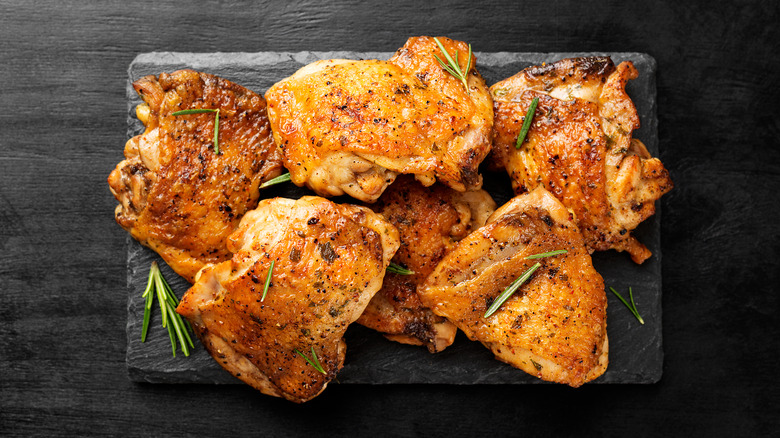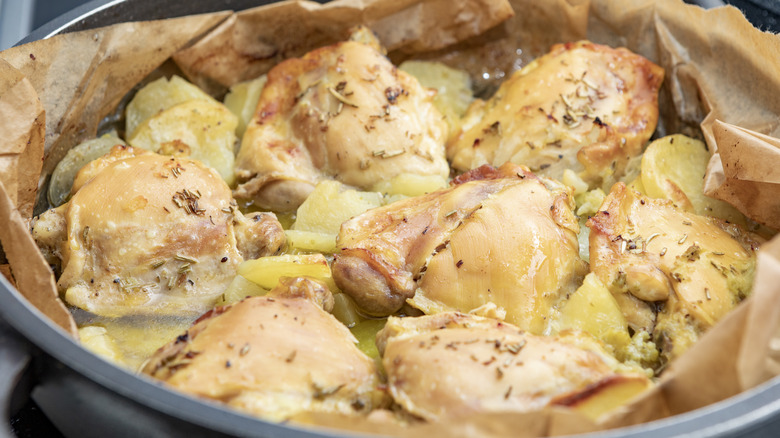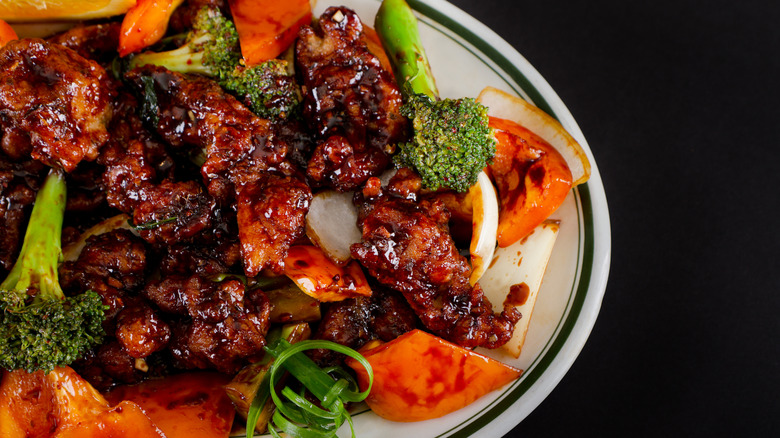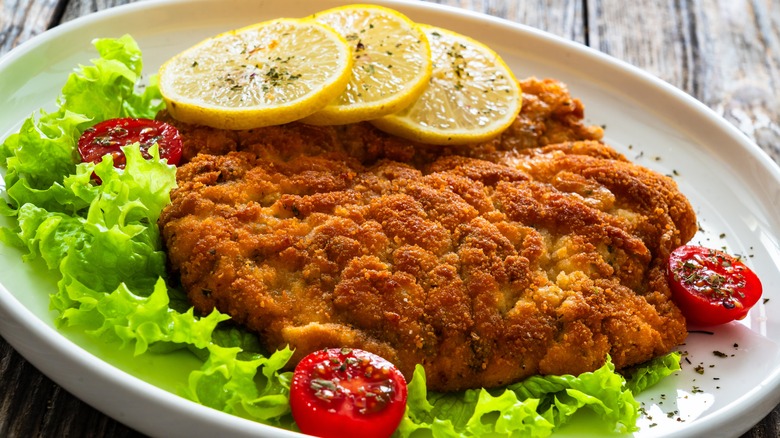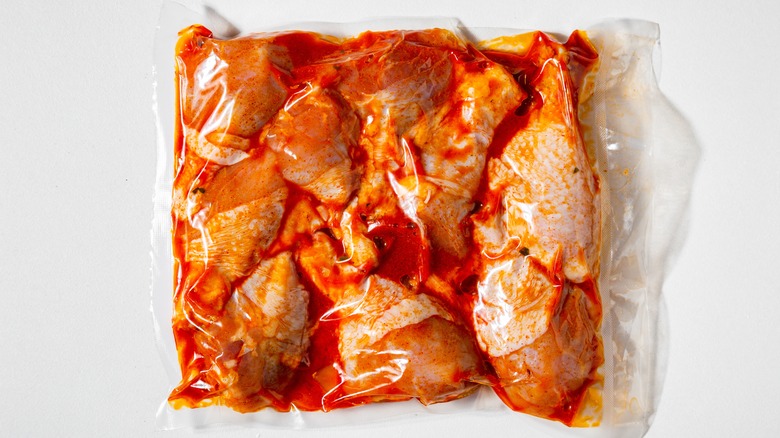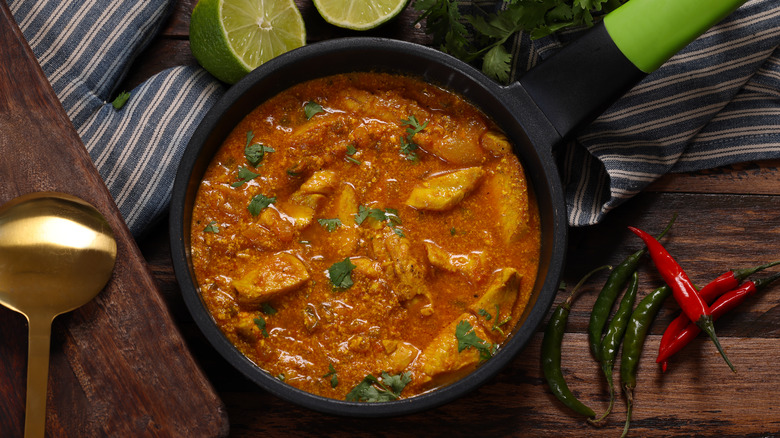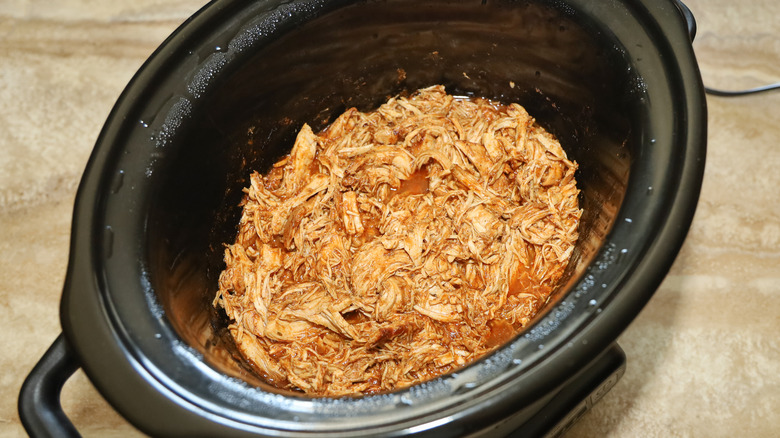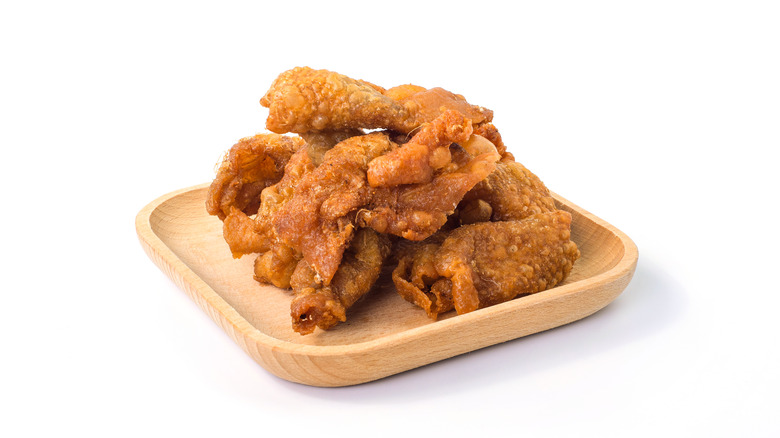The Boiling Water Trick And Other Hacks That Will Change How You Cook Chicken Thighs
Chicken thighs are a perfect protein to feed the whole family. There are a million different ways to prepare them across cuisines, from easy one-pan dinners to complex and impressive dishes to present to guests. If you're intimidated by this cut, fear not; there are many cooking hacks that can help you master the art of preparing crispy, flavorful, and tender chicken thighs.
Chicken breast gets a lot of attention, and people often think they prefer white meat, but chicken thighs are juicier than chicken breast, often less expensive, more versatile, and much harder to overcook. You can buy bone-in skin-on or boneless skinless thighs depending on your tastes and what your recipe calls for. Skin-on cuts are fattier, but they are the juiciest, and most flavorful. Learning how to prepare them to minimize excess fat and maximize crispy skin is the key. Boneless skinless thighs are leaner and perfect for shredding, pounding thin, stewing, or braising.
There are a few easy mistakes to avoid when preparing chicken thighs, and many simple tricks to learn. From timing and temperature (room temp or cold sear) to managing moisture (pat them dry or stew them), these easy-to-master hacks can help you get the perfect texture and flavor in your chicken thighs whether you're whipping up a quick weeknight dish or serving a dinner party.
The boiling water trick
It might sound strange when trying to achieve golden crispy chicken skin, but pouring boiling water over the meat can actually be just the trick! This is a common technique in some Asian cuisines. Salt or brine the chicken first. Then, when you're ready, place the pieces skin-side up on a rack in a baking dish. Simply boil the kettle full of water and pour the water over your skin-on chicken thighs. This boiling water trick will help to render out the excess fat and tighten the skin, preventing rubbery results and helping to ensure a crispy finish.
You can also submerge the thighs in boiling water for a few minutes, rather than pour water over top. Get a pot of water to a rolling boil, then place the skin-on thighs into the pot for just a minute. Some of the fat will melt out and the skin will tighten and shrink a little, all of which leads to crispier skin later when you bake or fry it. Move the chicken into a colander to drain, pat dry, then proceed to season and cook.
Alton Brown says steam them first
Celebrity chef Alton Brown is a wealth of knowledge when it comes to food hacks — like getting the perfect crust on a steak — and he has another tip to harness the power of moisture to achieve crispy chicken. He recommends steaming the chicken pieces before roasting them. Once again, this watery first step may seem counterintuitive, but steaming the meat helps reduce the fat, crisp the skin, and does a little work towards cooking them before they hit the oven. His chicken hack is geared primarily toward baked chicken wings, but it should work well for bone-in thighs or chicken legs, too.
Place the pieces of chicken in a steamer basket for a few minutes. Brown then recommends removing them from the steamer, patting them dry, and letting them cool down to room temp again. This process will help keep the fat locked into the skin layer and tighten the skin back up so that it can crisp effectively in the oven. After patting dry, season the thighs with salt and whatever spices you're using before popping them back in the oven.
Crisp skin-on thighs in a cast iron skillet
There are a lot of myths about cast iron skillets, but when it comes to crispy chicken skin, it's undoubtedly the right pan for the job. Not only does it achieve a perfect sear, but it can also withstand high temperatures and transition easily from stovetop to oven.
Get the pan nice and hot on the stovetop before adding some oil or butter. The trick is to get the pan hot enough first so that the skin won't stick. When a drop of water rolls across the surface (instead of instantly sizzling and evaporating), it's ready. While the pan heats up, pat the chicken skin dry to remove excess moisture. Then transfer the thighs to the hot skillet and sear them, skin side down, until the skin is golden brown and crisp.
You can keep cooking them on the stove, or move the pan to the oven for a more hands-off approach and even cook. If your dish has other ingredients or liquid, simply remove the thighs after searing, add the other ingredients, and bring to a boil. After reducing for a minute or two, nestle the thighs back into the pan and transfer to the oven.
Other pans, like stainless steel, can work as well. Just make sure your pan is "oven safe" before popping it under the broiler. And don't forget to wrap the handle with an oven mitt or towel when you take it back out.
Use baking powder and salt
These two inexpensive kitchen staples can easily do the trick when attempting well-seasoned and crispy chicken thighs. Most people already have kosher salt and baking powder in their pantry, and while the former pops up in any savory recipe, you may be surprised to find this non-baking application for baking soda.
Baking powder helps crisp chicken skin by drawing out excess moisture. Remember that baking soda can have a bitter metallic aftertaste, so a little goes a long way here. This trick works wonders when making crispy baked chicken wings as well as thighs. Simply sprinkle about a teaspoon over your raw chicken when you're salting, and toss well in a bowl or a sealed plastic bag to keep it from clumping together.
Brining your chicken thighs with salt is another easy way to season chicken thoroughly and keep it moist. If brining sounds out of your wheelhouse, rest assured it's actually very simple as long as you think ahead. Dry brining simply involves rubbing or generously sprinkling the chicken with salt. Wet brining means making a solution of water, spices, and kosher salt, and placing the chicken thighs into the bowl to brine for a minimum of four hours, up to overnight. When you're ready to cook, simply pat the chicken dry again before seasoning and roasting or frying. The salty brine will have already seasoned the meat, so adjust your next salting accordingly.
Bake and then broil skin-on thighs
Baked chicken thighs are delicious and easy to prepare. There are so many recipes you can try from all different cuisines and flavor palates. You just need to adjust the bake time and temperature for boneless or bone-in cuts. Skin-on thighs can take a high heat, up to 400 degrees Fahrenheit, for a good half hour or more. If you're aiming for maximum crispiness and minimum fat, you can prop the pieces up on a rack in the roasting pan so the dripping can drain.
If you've ever baked skin-on chicken thighs and found that somehow they still came out soft or rubbery, you might want to add this simple extra step. If the skin is still looking soft and fatty near the end of baking, try sticking them under the broiler for just a few minutes to crisp up the skin. The broil function in your oven essentially sears the food from above at a very high heat. Don't leave anything under the broiler too long, or you'll burn it. But just a few minutes under the broiler can take your dish from soft to crispy-crunchy. Make sure the chicken is cooked through already before you take this step or you'll run the risk of serving up thighs that are burnt on the outside but raw in the center.
Flavor baked chicken thighs from below
When baking chicken thighs, add flavor by placing slices of fruit or vegetables at the bottom of the roasting pan (like tangerines). They not only help flavor the meat but can also turn into a wonderful side dish to serve with the chicken.
Potatoes, squash, artichokes, and olives are all delicious with chicken thighs. The chunks of vegetables elevate the chicken off the bottom of the pan to keep it from burning and sticking. Meanwhile, the chicken fat will drip down into the vegetables and flavor them as well, resulting in a delicious one-pan dinner. If you're worried your potatoes won't cook in time, you can par-boil them for a few minutes before baking. Or, remove the chicken when it's done and pop the veg back in the oven for a few more minutes.
Adding liquid to the pan is another great way to ensure moist chicken thighs. Chicken broth and wine are common, but a splash of vinegar or soy sauce can be delicious too. If you're starting the thighs in a cast iron skillet, remove them after browning and pour some broth and/or white wine into the pan. The liquid will deglaze the pan; scrape up all the tasty chicken bits that have stuck to it. Then, let it reduce for a minute or two before nestling the meat back in and baking. Try not to have liquid more than halfway up the thighs or else you risk soggy skin on top.
Sprinkle some sugar on top
Even the most savory dish can benefit from a sprinkle of sugar or a drizzle of honey. You might be surprised how often a tablespoon or two of sugar pops up in a chicken recipe. Particularly in Asian cuisines, the addition of sugar helps achieve the caramelized finish or sticky sauce that makes the chicken so darn moreish. Brown sugar will caramelize beautifully on top of baked skin-on chicken thighs and add a golden color as well as a rich and salty-sweet flavor.
Honey, maple syrup, or agave can also balance out the flavor of a salty soy-based stir fry. It's easy to slice up boneless chicken thighs to prepare a crowd-pleasing favorite like orange chicken or sweet and sour chicken. And don't be afraid to think outside of the box: You can even use a little jam to add fruity flavor and sweetness rather than straight-up sugar.
Pound out boneless thighs for crispy cutlets
You may have purchased thin chicken breast cutlets before, but did you know you can also pound boneless, skinless thighs out to make thin and delicious chicken cutlets? Dishes like chicken piccata or chicken schnitzel work well with thighs as well as breasts. In fact, thigh meat will be likelier to stay juicy when fried, as thin breast meat pieces are drying out.
Open up a boneless skinless chicken thigh and place it between two pieces of plastic wrap or parchment paper. Then, use a meat tenderizer or kitchen mallet to gently pound it to about ½ inch thickness. Next, dredge the pieces in flour. If you're aiming for chicken piccata or something similar that doesn't feel breaded, you'll place these floured pieces into a piping hot pan with some butter, oil, and maybe some white wine. If you want a crispy chicken cutlet, dip the floured chicken meat in some beaten egg and then breadcrumbs before frying. The result will be a crispy shortcut to a fried chicken.
Marinate chicken thighs overnight
If your recipe routine is feeling stale, consider adding a marinade to your next dinner preparation. Chicken thighs take on marinade flavors really well, whether they're bone-in or boneless. The cooking itself is easy, and marinating the chicken overnight — or even for just a few hours ahead of time — will extend the depth of flavor and keep your night-of preparations to a minimum. Throw the chicken thighs and marinade in a large bowl or a plastic bag and keep them in the fridge until about an hour before you're ready to cook them.
You can marinate chicken in a lot of different ingredients. A mix of Dijon mustard, oil, lemon, salt, and pepper will do the trick in a pinch. But you can easily go for a more Asian flavor profile with a honey and soy-based marinade, or try an Italian-inspired dish like chicken Marbella that combines oil and vinegar with spices, olives, capers, and prunes.
Another great option is to marinate chicken thighs in yogurt. This technique is very common in Southeast Asian and Middle Eastern cuisines. Marinating in yogurt helps tenderize the meat and keeps it super moist. You can marinate whole thighs or pieces of boneless, skinless chicken for shish kebabs. If dairy isn't in your repertoire, try using tahini as a creamy dairy alternative.
Cook chicken thighs in liquid
Curries, soups, and stews can all be made with boneless, skinless chicken thighs. It's easier to feed more people with fewer pieces of chicken this way, but you won't compromise on flavor. In fact, stews, braises, and curries are some of the most flavorful chicken dishes out there. Many cultures have their version of this dish, and all of them are delicious. You can experiment with different flavors and expand your chicken repertoire considerably.
Try your hand at homemade chicken soup, Thai-style chicken curry, or chicken chili. When cooking in broth, coconut milk, or tomato sauce, the meat won't dry out. You can also poach your chicken thighs in a little liquid and spice until it's tender and then shred the meat. This meat can be used in salads, pasta dishes, tacos, and more. Unlike other recipes that require a full thigh or two per person, just a few boneless chicken thighs can be shredded into enough portions to feed a whole family. This is an excellent way to stretch the value of a more expensive ingredient and make sure everyone gets some protein.
Slow cook your chicken thighs for deep flavor
If you have more time, want to get a hands-off meal prepped before work, or you'd like an easy-to-prepare but impressive one-pot dish that will be ready by supper time, boneless chicken thighs take well to being cooked low and slow. And when it comes to hands-off cooking, the slow cooker is your best friend. You can literally set it and forget it while you go about your day. There are many chicken thigh dishes that can be made in the slow cooker and yield flavorful meals. Try this slow cooker chicken mole recipe, or make pulled chicken for tacos or sandwiches.
If you're looking for a great dish for your next dinner party that won't require a million ingredients and the skillset of a professional chef, a coq au vin (which translates to "chicken in wine" in French) might just be the thing. This dish can simmer for hours until the meat falls apart. A few simple ingredients like chicken, wine, broth, herbs, onions, and garlic are added to a large pot or Dutch oven, brought to a boil, then reduced to a simmer. After the initial stage of getting everything in the pot, you can essentially walk away and let it cook while you focus on other dishes, tidy up, or set the table. If you want a richer, more caramelized final product, use skin-on thighs and transfer the dish to the oven instead of simmering on the stovetop.
Bake the chicken skin separately
It might sound strange, but chicken skin chips can be a tasty low-carb snack on their own. Crispy chicken skin is a salty, crunchy, umami flavor-packed bite. Don't knock it 'til you try it! If the chicken recipe you're cooking won't lend itself to a crispy skin (perhaps you're cooking in liquid) but you've only got bone-in thighs on hand, don't waste the skin. Try removing it and baking it separately for a bonus snack or side dish.
It's easy to remove the skin from chicken thighs; you might not even need a knife. Just pull the skin right off, trim the excess fat, pat it dry, sprinkle it with salt, and lay it out flat on a baking sheet. You can line your baking tray with parchment paper to minimize mess. Chicken skin crisps up beautifully in around 10 minutes in a 400-degree Fahrenheit oven (or around 12 minutes in the air fryer at the same temperature). A lot of the fat renders out, leaving a super crispy, crunchy, and salty chicken chicharrón, much like pork cracklings. The crispy skin can be eaten straight, or crumbled as a topping on salad or soup.
